|
Getting your Trinity Audio player ready...
|
As tourists enjoy springtime activities, backcountry adventurers await the consolidated snowpack for safer exploration. The quiet call for alpine adventure begins before the melting snow, creating a small window of opportunity.
“A pair of skis are the ultimate transportation to freedom,” Warren Miller.
The Alpine Spring:
It’s that time of year again. The long pull of winter hibernation comes to an end as the sun regains its dominance over the land. Social media pounces on the opportunity, showcasing images of warming temperatures and budding flowers. Cheerful hello’s and good mornings are met with enthusiastic responses, and people start wearing bright colors again, mirroring the vibrancy of the transition to summer…but that’s not the spring I’m talking about.
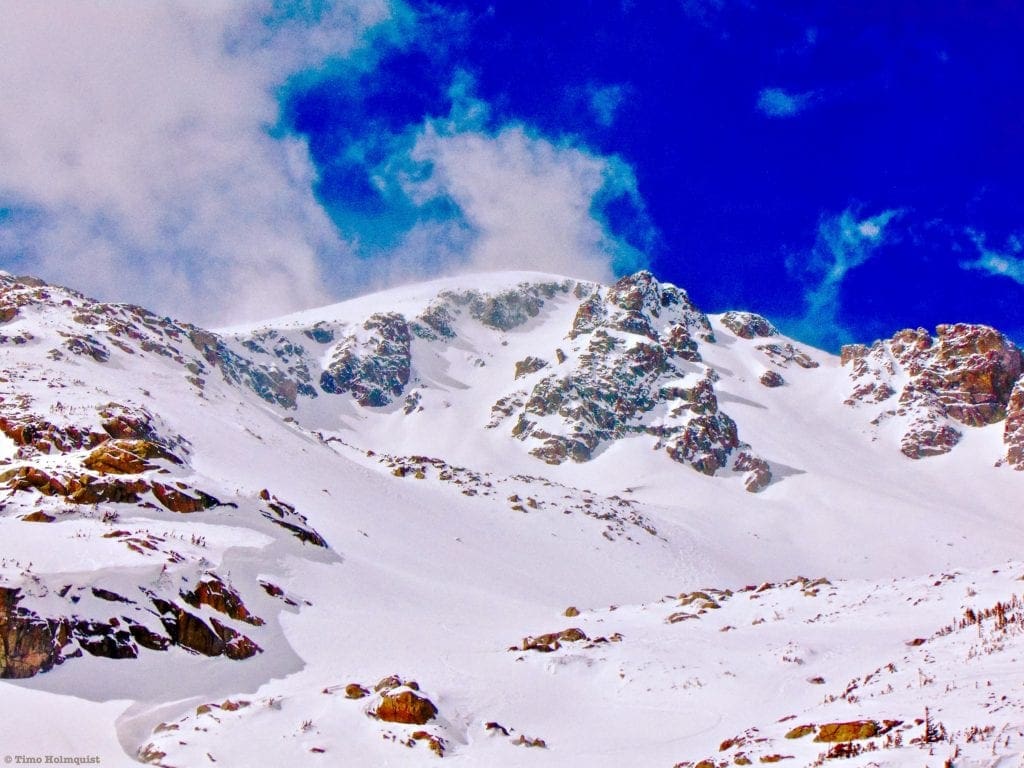
Pawnee Peak in the Indian Peaks Wilderness, Colorado.
This is a story about the other spring, the alpine spring: the quiet beckoning of backcountry opportunity long before the snow recedes. As beachgoers and flatlanders flock to the cherry blossoms and lemonade stands, up high, the mountain snowpack consolidates. With consolidation comes windows of opportunity to finally, and more safely, get out into the great wild yonder.
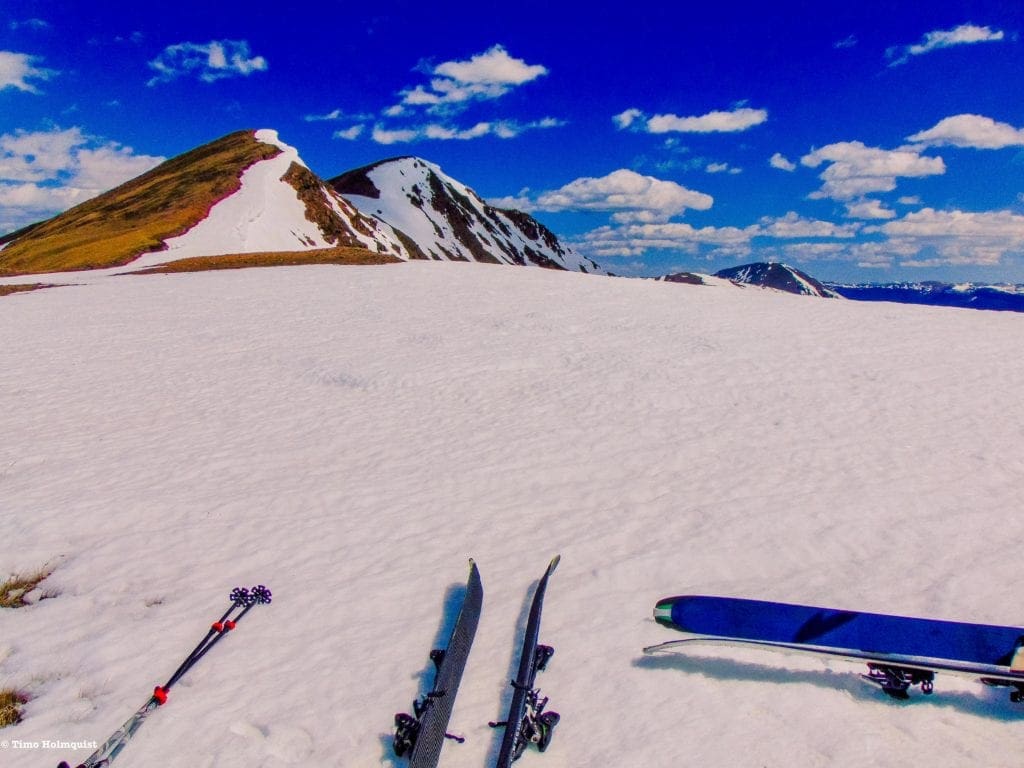
Skis, mountains and blue skies
Quick Navigation
Article Navigation: Click on any of the listed items in the table of contents below to jump to that section of the article. Similarly, clicking on any large, white section header will jump you back to the Table of Contents.
1) Colorado A Tale of Two Seasons
2) Ok, but why?
3) Get After It
- Backcountry Gear
- Backcountry Planning
- Guides
- Education Tips
10) Further Reading
Colorado: A Tale of two Seasons
Ah, Colorado, the centennial state. What springs to mind? Alpine lakes and summer camping?
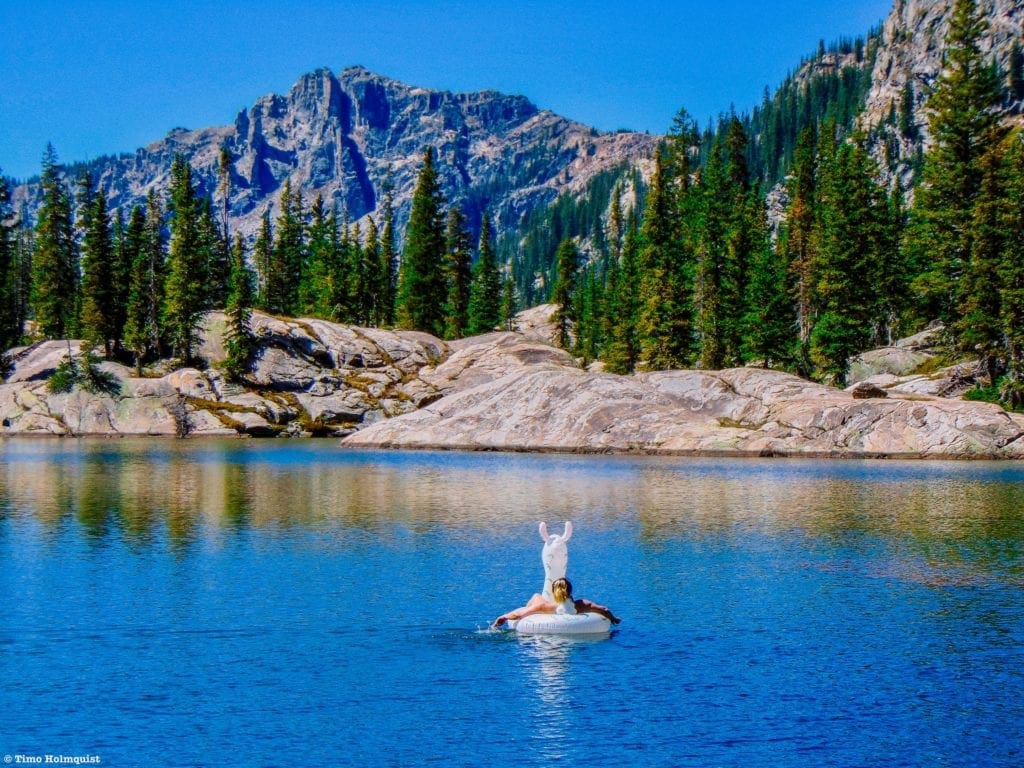
Floating away in the alpine
Or, maybe winter nirvana at a fancy resort?
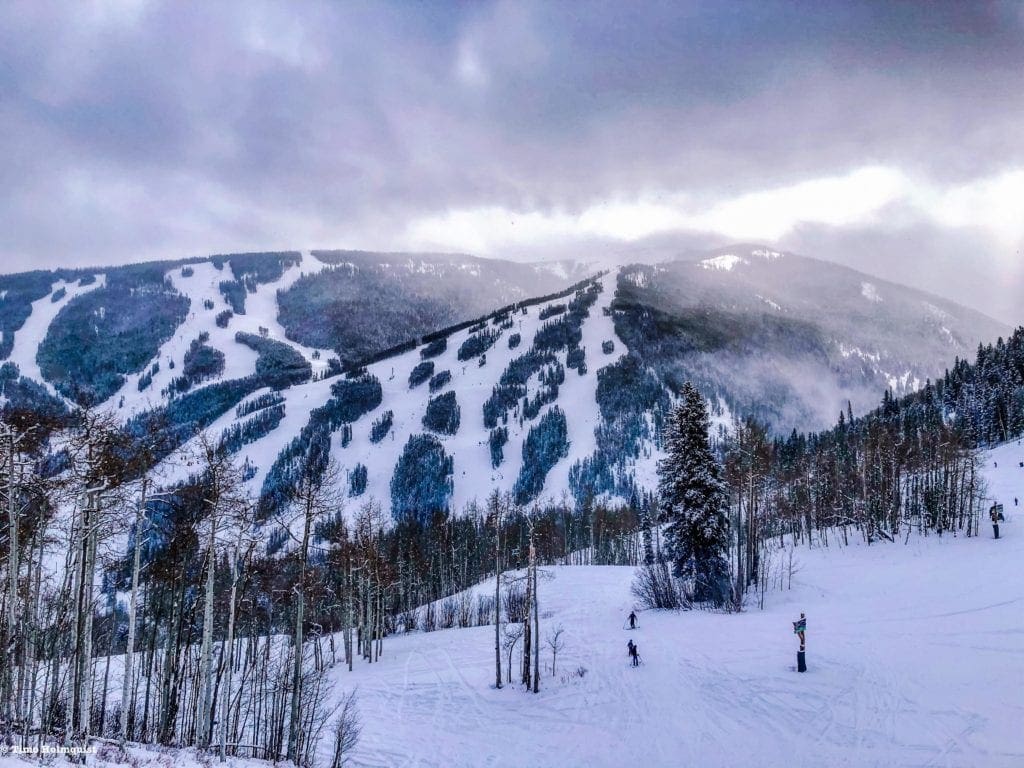
Beaver Creek Ski Resort on a particularly moody day.
Both of those thoughts are accurate and as much a part of Colorado as any other. But the state has always been a bipolar one, arguing amongst itself over which season is better, summer or winter. Autumn doesn’t really make the conversation; it’s too short. If you’re lucky, you get a few weeks of Aspens changing before the first winter snow rolls in. Ok, well, what about spring?
For the dedicated, it’s a slower time; resorts begin to close, the spring breakers head home, and the state empties. Mud season, some call it, as the lower elevations liquidate their snowy assets. But those mountain tops and ridges aren’t done yet. Most years, they hold on to their winter coat well into June. Why sequester yourself until the snow disappears? If you time it right, you’ll be heading out in the cold and skiing down in a bathing suit on a stabilized snowpack.
In the most simplistic sense, the Colorado alpine offers two seasons, snow and not snow. If you don’t like sitting in your house for half a year waiting for the white stuff to melt up high, you might as well figure out what you can do with it. Snowshoeing and cross-country skiing are reliable options, but I want to focus on backcountry skiing, which is, in my opinion, the best way to enjoy an alpine spring.
“Skiing is the next best thing to having wings,” Oprah Winfrey.
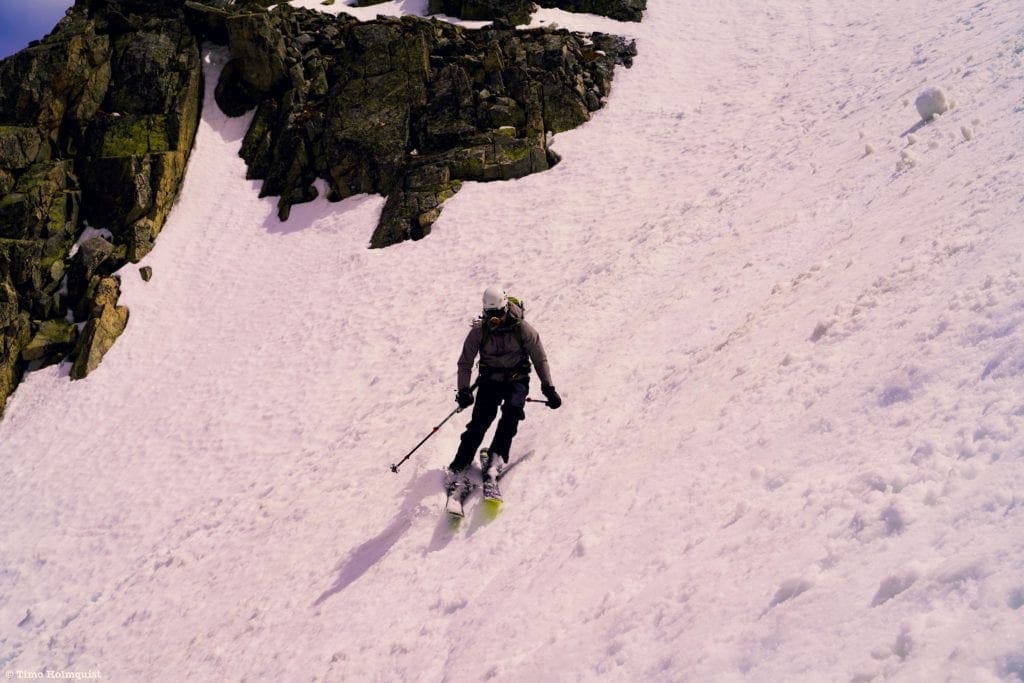
Spring couloir skiing in the Front Range.
Ok, but why?
“Why do you backcountry ski?” a friend of a friend asked one night as I sat at my local watering hole.
The night had been fairly mundane up until that point, but confronted with the simplicity of the question, I balked. WhyYyyYyyYyy. The strange cadence of the word reverberated endlessly in my mind. A thousand strands of thought failed to coalesce into anything coherent, and panic descended. I looked to my left, as if the answer would be sitting there patiently waiting to reveal itself, but of course: nothing.
Why do I backcountry ski?
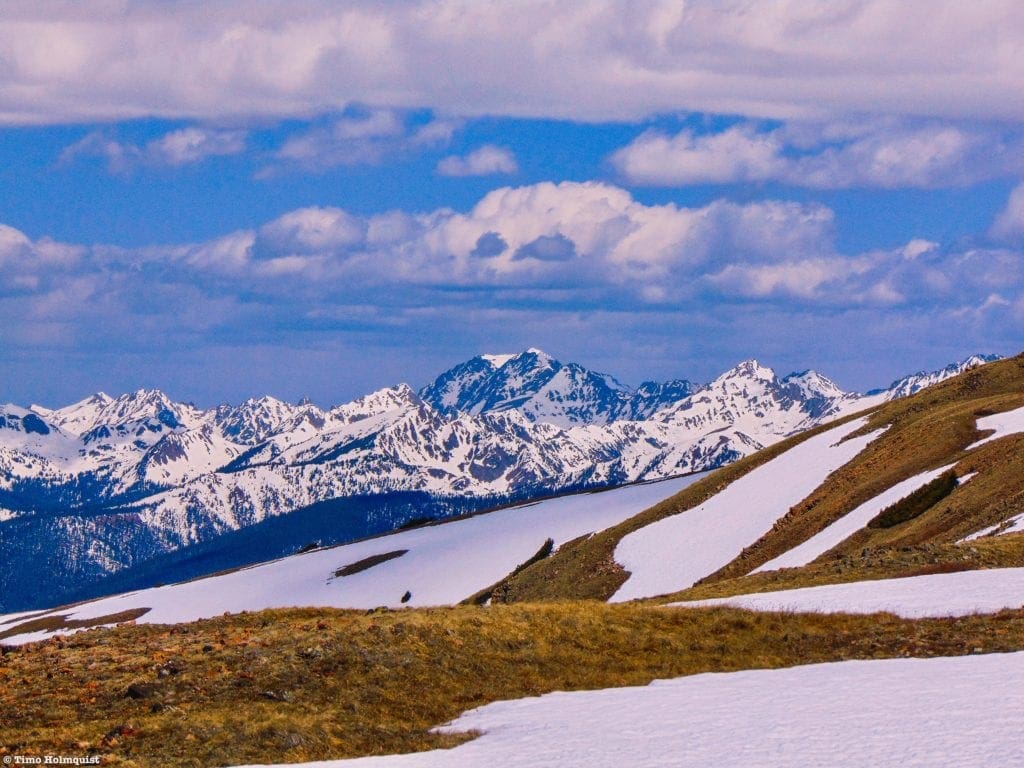
The Gore Range in spectacular color.
Justifying something so incredible to this person I’d probably never see again seemed foolish. Didn’t everyone know how great it was? How liberating it is to ski an alpine couloir or a wide-open slope? How beautiful an alpine spring really is?
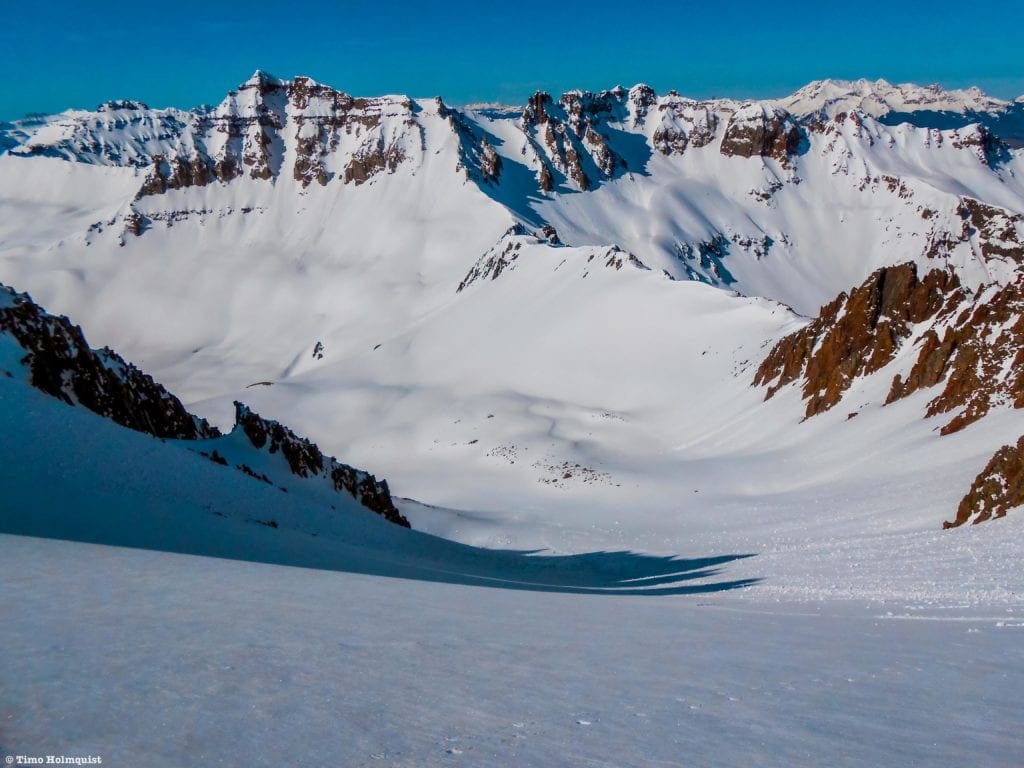
The San Juan Mountains in spring.
“Just seems silly to skin uphill when you could use a chairlift,” the nameless friend of a friend said, trying to goad me into an answer.
Don’t get me wrong, chair lift skiing is great, but it can be limiting. Utilizing an alpine spring means not dealing with migraine inducing resort traffic. It means not standing in hour long lines for gondolas or paying $8.00 for a Gatorade. It means freeing yourself from $200 lift tickets, slow zones, and people dodging. It means staring at a map and realizing instead of a few thousand acres of skiable terrain: you have millions. Backcountry skiing is a creative expression of limitlessness. If there’s enough snow and enough of a slope, chances are you can ski it. In the backcountry, I can do something exhilarating in a place that’s still untamed, untarnished, and unbelievably gorgeous.
“Aren’t there other activities you can do in the spring?” The nameless nonfactor continued, capitalizing on my silence.
Well, sure, and this article isn’t meant to disparage those options. Between biking, rock-climbing, running, canyoneering, rafting, and hiking, there is no shortage of outdoor activities in Colorado. However, some of us want to go higher, and with an alpine snowpack that lasts an average of 7-8 months, at a certain point, avoiding snow becomes harder than learning how to deal with it.
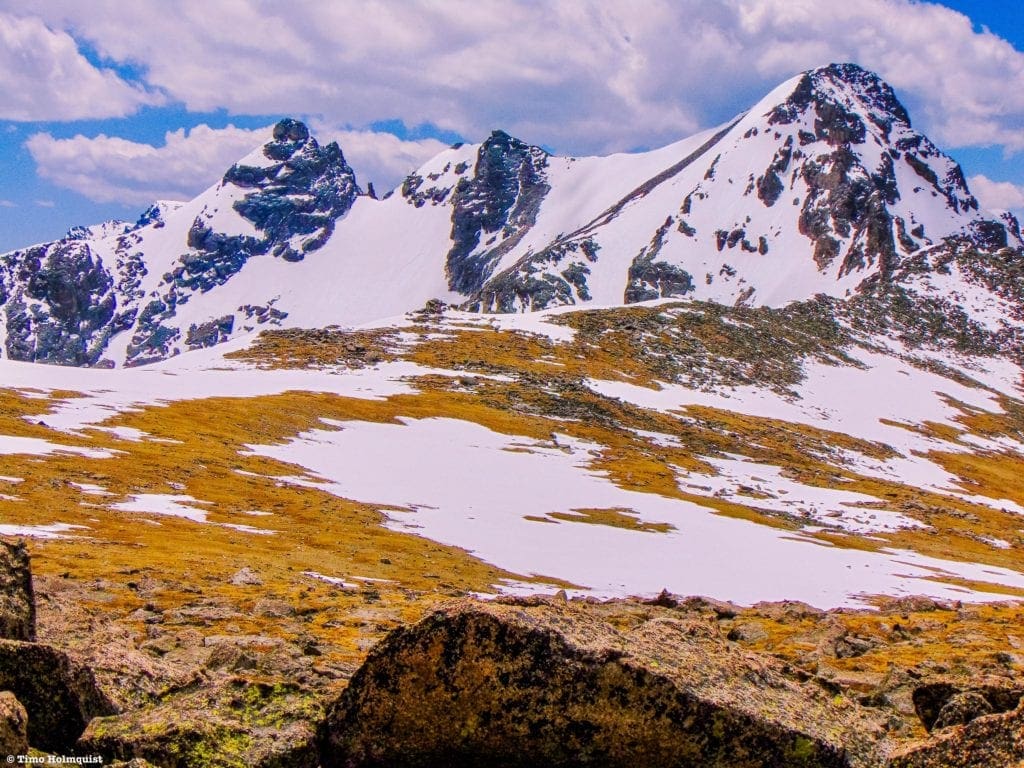
May on the Continental Divide.
For me, alpine springs are for skiing. I backcountry ski to extend my season, and I do it to earn my turns. I do it to stay in shape, and I do it for adventure. I do it stay grounded, and I do it fly. I do it for a thousand quotable reasons, and yet, faced with the daunting task of answering for myself, I drew blank. How do you bottle a scene like this?
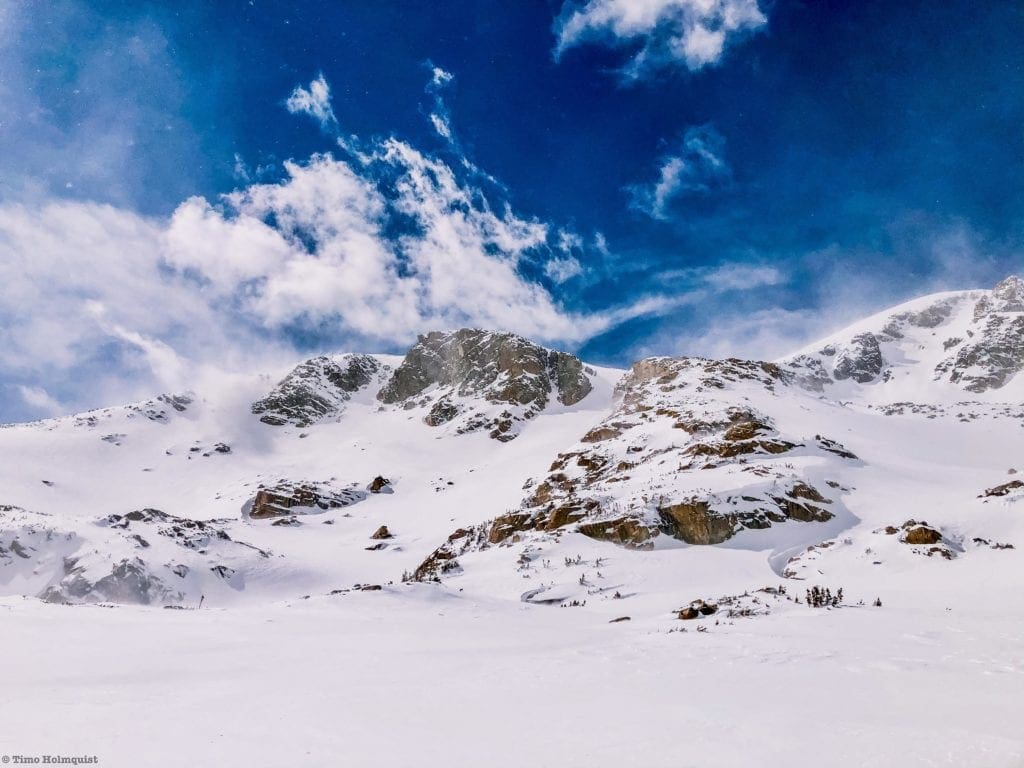
Somewhere in the Indian Peaks Wilderness.
Finally, just as the moment of silence slid into awkward territory, words flooded into my head: brilliant, poetic, an answer to bed the critics and set fire to everyone’s doubt. Showtime buddy, knock it out of the park. Why do I backcountry ski?
“Why not?”
…Oof. Swing and a miss.
The friend of a friend shrugged and proceeded to ignore me for the rest of the evening, unaware of the silent quagmire they’d put me in.
Asking why someone does something can be uncomfortably intimate. It’s an examination of the things you hold dear, suddenly and violently pulled out into the public sphere for analysis. Is there a relatable thread the questioner can find? A common denominator that validates your reasoning? If yes, the activity is acceptable; if no, well, you won’t be winning any more converts to the cause.
Yet, here I am, trying once again.
“Well, why even bother?” says the super local, a regular Grinch in the making, as they sit in dimly lit bars, guarding their secret backcountry stash as if it’s only theirs. Half the time, you expect them to turn into Golem from the Lord of the Rings, eyeing everyone suspiciously and muttering “my precious” under their breath.
Somewhere along the glorification of outdoor adventures came the attitude that only the select few get to appreciate them. While there are certainly some who shouldn’t or may not want to pursue backcountry skiing, that decision doesn’t lie in the brittle grasp of hypocrites who want to monopolize a feeling. After all, public lands are public for a reason.
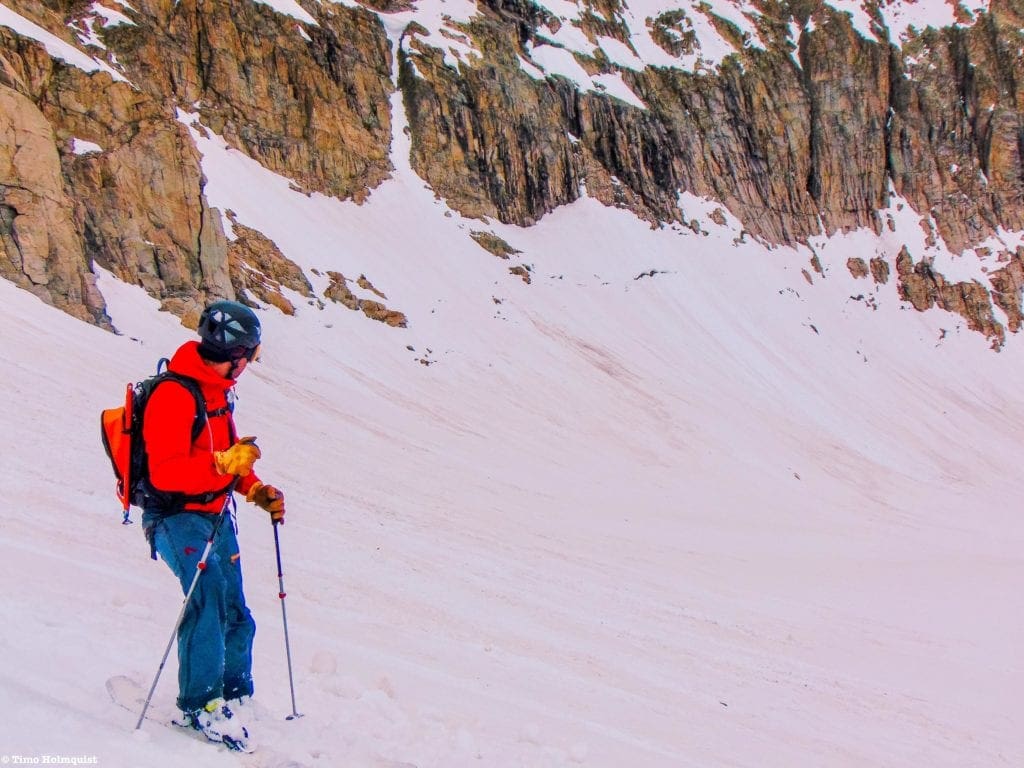
Scoping out the next set of turns in the backcountry.
This article is about the benefits of backcountry skiing. If it isn’t for you, at least you know what you like. If you’re interested, read on. If it makes you angry that I’m spreading hype about an outdoor activity, try to remember the feeling you got when you first discovered something you love. Support and measured encouragement always go farther than hate.
At the end, I’ll provide links and resources to further your education. This creative fluff will not be enough to wrangle a successful outing, but if it gets the gears turning, that’s a win. Some of the best days of my life have been on skis; some of the worst have as well. Every warm, bluebird day has a cloudy, bitterly cold cousin who takes you two steps closer to frostbite. The elements are fickle, but they are not insurmountable; armed with a plan and a mission, you can make backcountry work for you. When it does, the experience is incredible.
“The mountains are calling, and I must go,” John Muir.
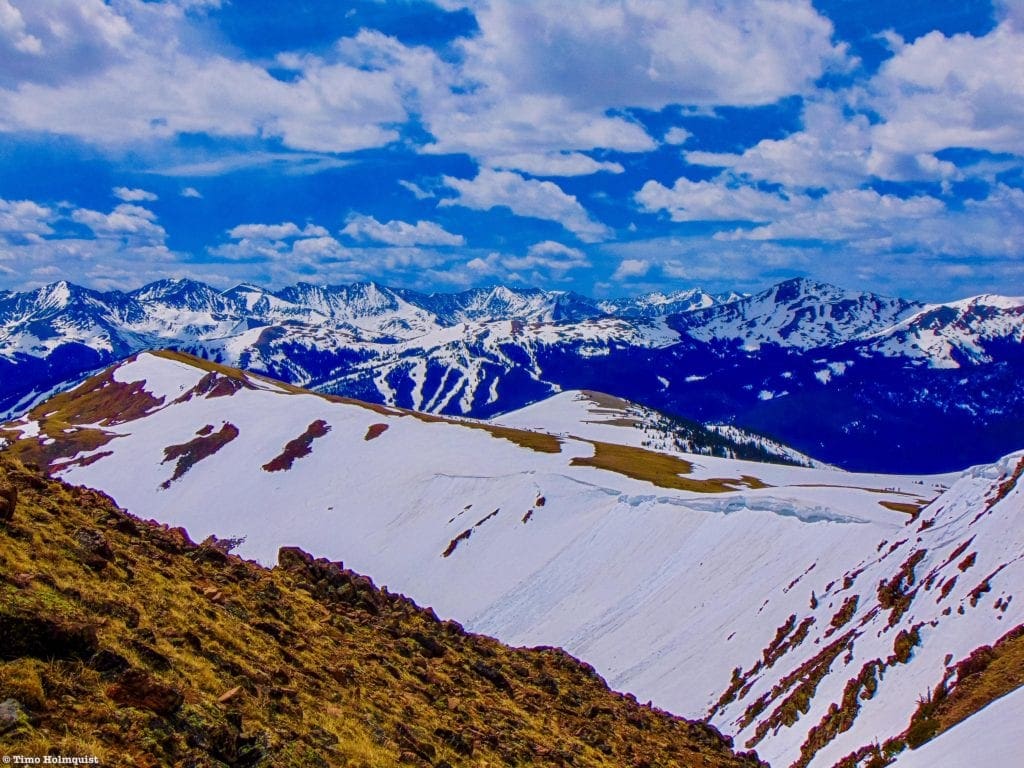
Beyond the resort ropes.
Get After It
“Skiing is a dance, and the mountain always leads,” Unknown.
It’s really about all of it, every moment of the experience. To truly be into something is both inspiring and uplifting. So, let’s take this journey together.
Assuming you’ve got the basics down, the right form, and the right gear, opening up the possibilities can be as easy as stepping outside. Of course, that isn’t often easy, especially if, like me, you have mattress foam. Three AM brain always whines the same.
Bulldoze through the mental roadblocks, inhale some caffeinated glory and commit to the struggle. It doesn’t last forever. Always remember, this too shall pass.
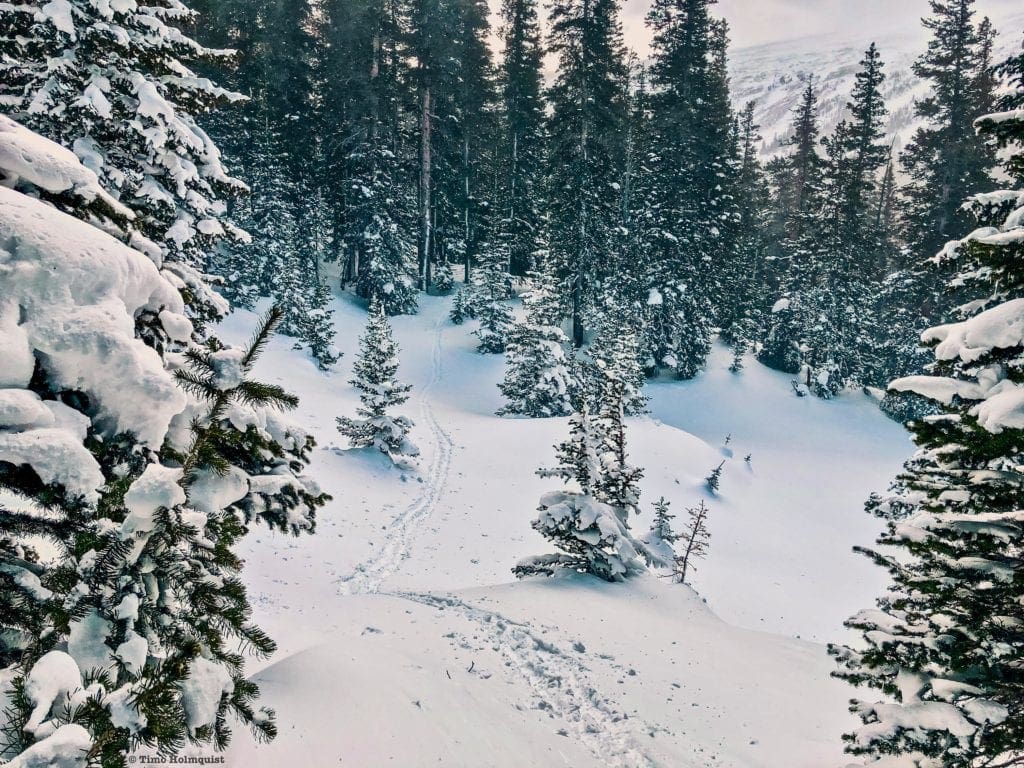
Ski tracks through the snowy pines.
Once the caffeine kicks in, or however you chase awake, let anticipation bubble. Drive to the tune of your playlist, make it fun and make it loud. Success is built on the backs of all those little moments: before, during, and after. Guard your positivity like a precious stone because it’ll keep you chugging through the highs and lows.
Trust that there will be both, and you won’t be disappointed.
Outdoor adventure is predicated on your mental and physical wellbeing. A connection to nature is waiting to be made, and it can drive your happiness for as long as you let it. Physically, backcountry skiing is demanding. If you’ve been skiing through the winter, let backcountry bridge you to the summer. If you’re trying to trim the fat, use it as a springboard towards that summer body. If you’re tiptoeing into the sport, start small or hire a guide. Let the activity work for you; it’s never easy fighting against the grain.
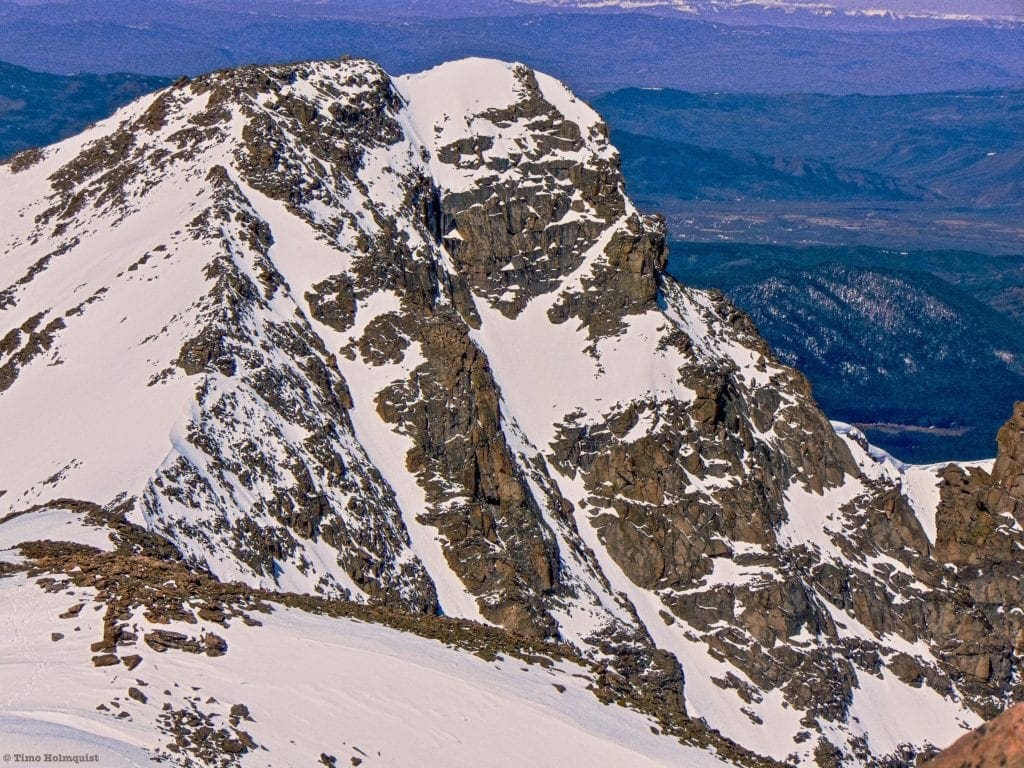
Typical spring alpine terrain.
Springtime skiing usually starts cold, but it likely won’t end that way. Whatever layers you have on will slowly spill off as the sun makes ready to rise. Time it right, and those first glimpses of daylight can be absolutely encapsulating.
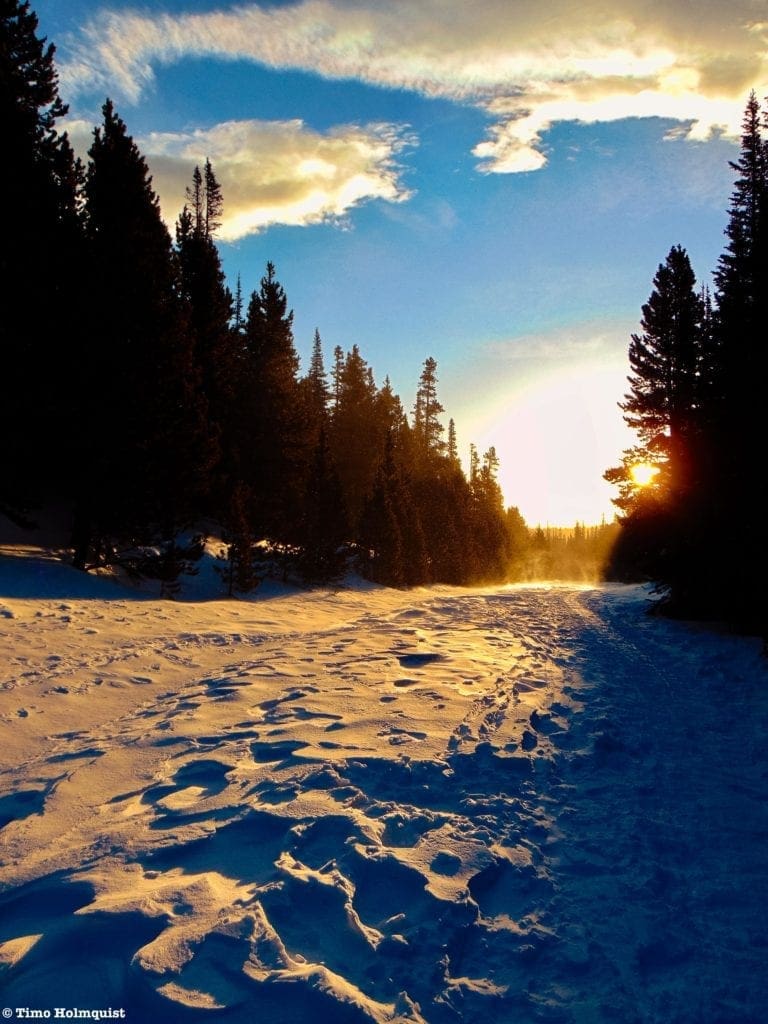
An early spring sunrise.
There’s beauty to be found in an alpine spring that no other season can touch. It’s got a bit of both, the nippy start of a brutal winter, and the warmth of an afternoon sun. The crowds are down, and the views are superb. Crisp, clear days balance the shoulder seasons.
It’s also the best time to get into it. There will still be storms, it can snow any month of the year if you’re on a big enough mountain, but the windows between them widens. The days get longer, and there’s more light to play with. Avalanche danger begins to lessen when the snowpack consolidates. As with any outdoor activity, there are risks, and less doesn’t mean zero, but managing them becomes easier.
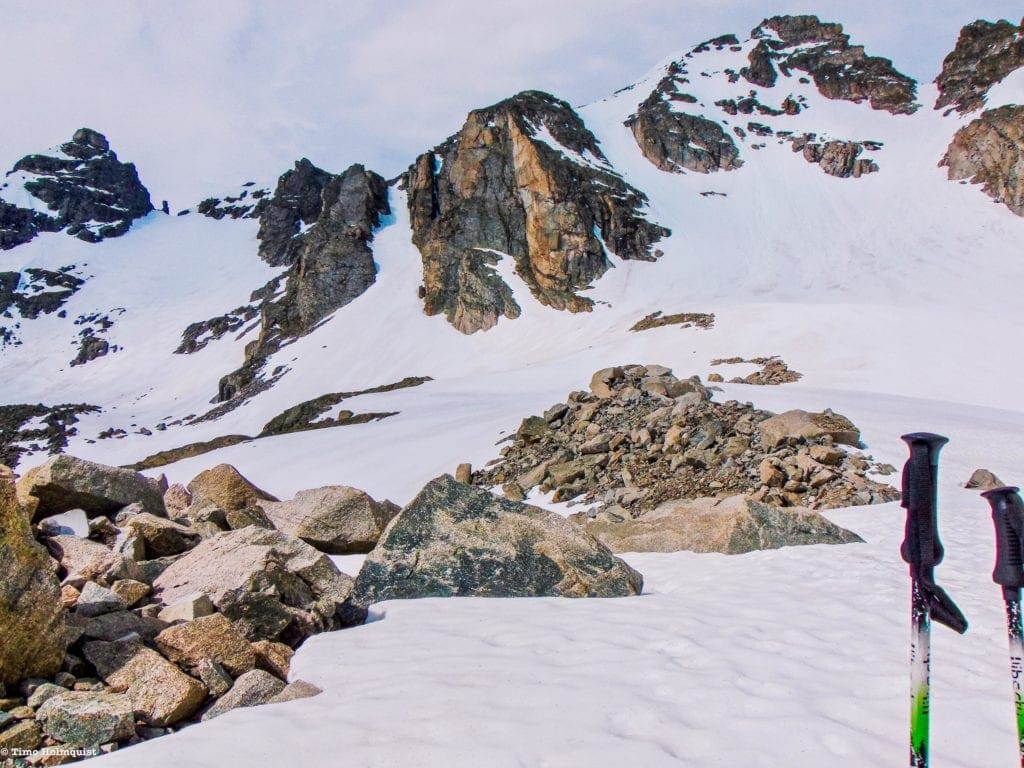
A world of rocks and snow.
There’s a lot to be said for spontaneity, but it should never be your guiding star. Purposeful planning guarantees better outcomes, especially when you tangle with nature. The natural world doesn’t operate the way we want it to, and therein lies the magic. Manifest destiny was a failed perspective; you don’t ever really conquer nature. It’ll be here a long time after we’re all gone. The people who dredge swamps to build cities always act surprised when residents complain about mosquitos. We are guests on a planet we didn’t create and barely understand. Develop a plan but be ready to roll with the punches.
Once you get going, wide-eyed and bushy-tailed, the initial stoke will fade. Sometimes it isn’t for hours; sometimes it’s only a few minutes after you leave the trailhead. It’s impossible to sustain limitless anticipation, but it is possible to transfer stoke to rhythm.
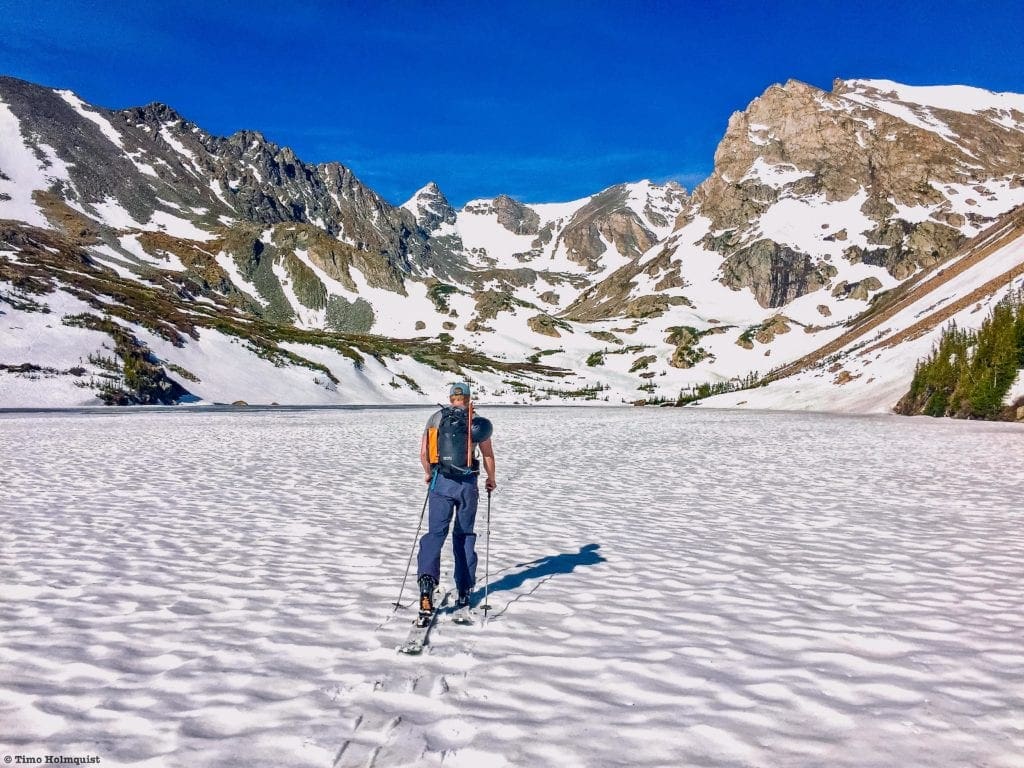
Skinning towards the goods.
Everything we do in life is patterned: eat, sleep, work, etc. The routines carry us, even if they seem boring. Outdoor adventure operates the same way, the act of movement may seem monotonous, but there is an art to it. Skinning through the white canvas of a slowly melting snowpack is sublime. Slide, lift, slide, lift. Breathe in through your nose, out through your mouth. Feel the expulsion of anxiety as thoughts narrow to the task at hand. Keep it simple.
As the day warms, so do your prospects. With longer days, you can add extra miles or slow the pace down. Nothing feels worse than rushing through an activity meant to be enjoyed. Even the tougher days can be rewarding if you have enough time to appreciate where you are. Ultimately, that’s one of the biggest reasons to get out into it. Every once in a while, take a second to stop and look around. It feels good to know you’re a part of something bigger, and it’s easier to do when there aren’t thousands of Hawaiian shirts and sandals sharing the trail with you.
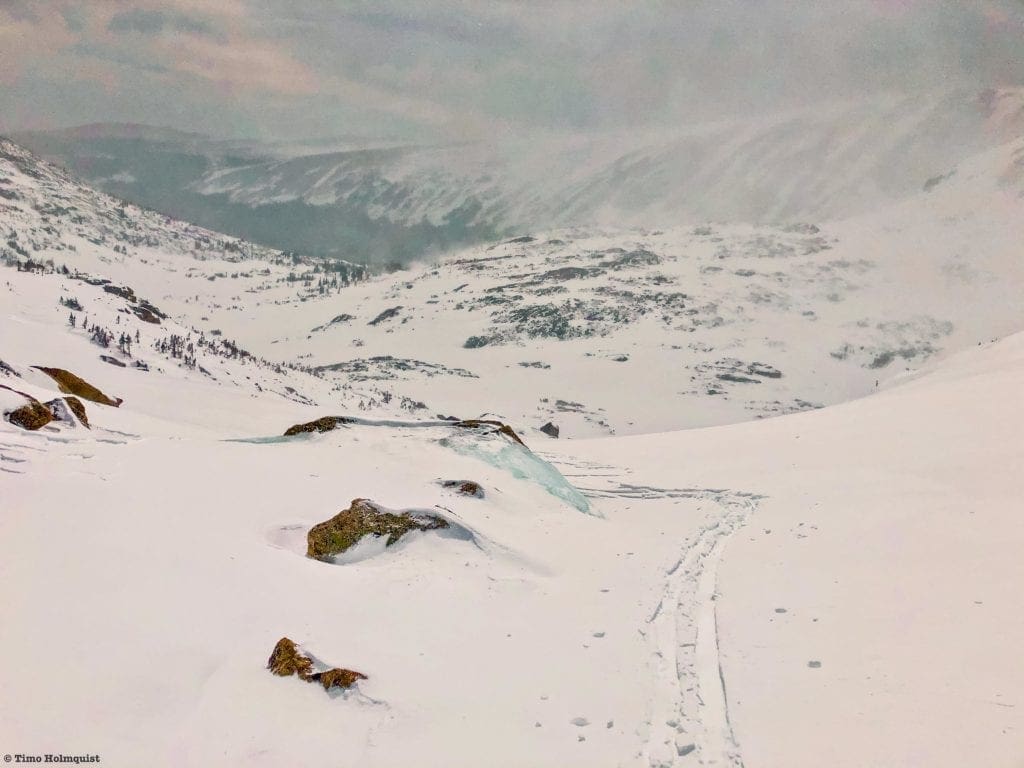
Getting into the alpine.
The Grind comes next, and it’s exactly what it sounds like. In order to ski down, you must climb up. In some areas, it’s fairly straightforward, in others, it’s a journey. Sometimes the slope steepens too much for skins to handle, so the extra gear comes out: spikes and crampons that attach to boot bottoms. Slow and steady up the tedious terrain.
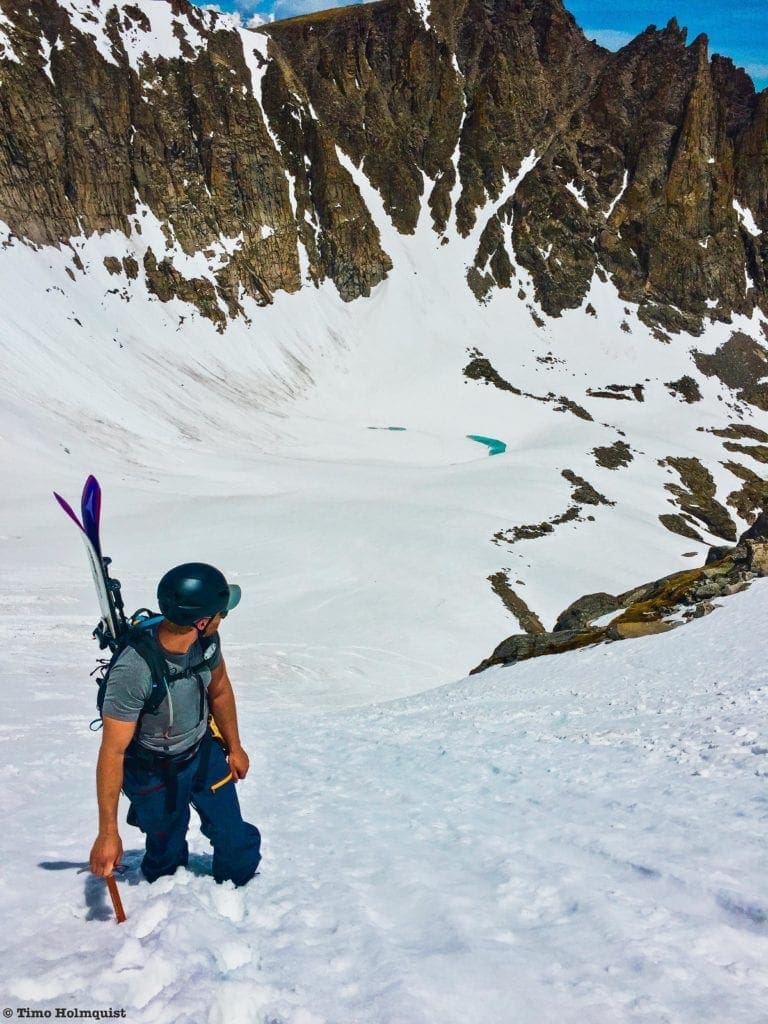
Climbing up a couloir.
Your muscles will hurt, your breath will become ragged, and your brain may betray you. “Yup, that’s enough, let’s pack it in,” it’ll say, under the guise of watching your back. Sometimes it’s right; no one musters peak performance every day. Sometimes you know it isn’t true, but the suggestion is too good to ignore. That’s ok too. If you didn’t know your body before, the Grind will get you there. Feeling those muscles firing can be transcendent or terrible. The best thing to do is to listen to what your body is saying.
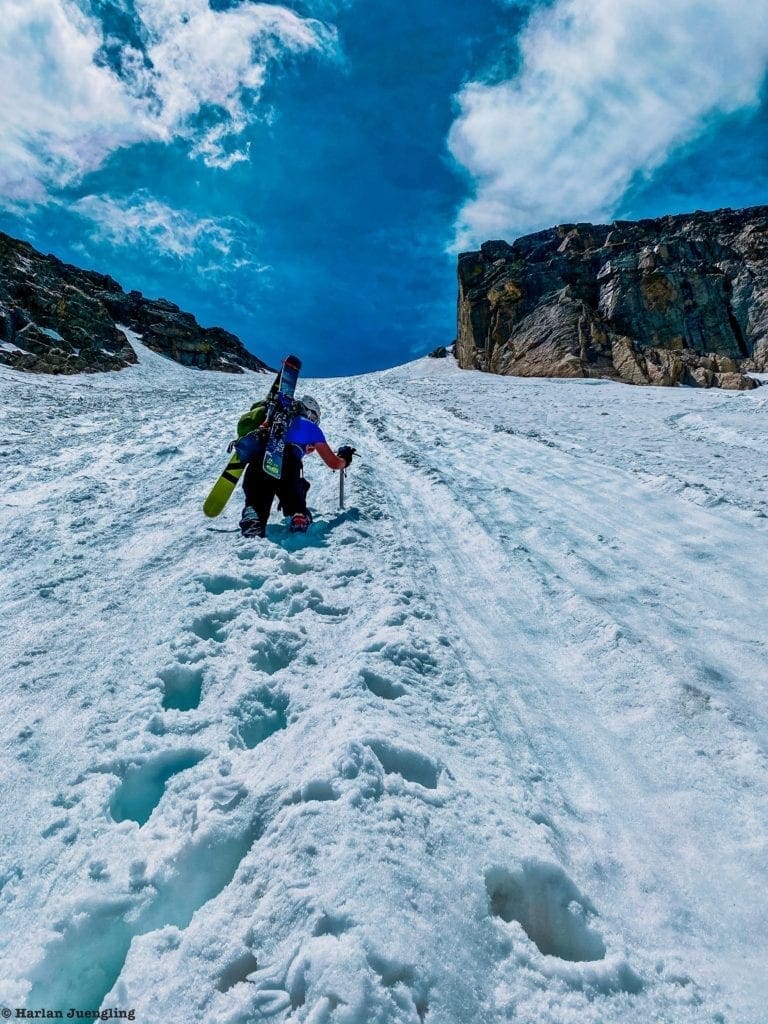
Ascending through steeper terrain.
One of the greatest American mountaineers, Ed Viesturs, has a famous phrase, “Getting to the top is optional, getting down is mandatory.” Those are words to live by. Go as high and as far as your body and mind let you go. Sometimes you make your goal, many times you won’t. Adapt, adjust, reset and accept. When the Grind gets real, remember the reason you brought skis. If it took you four hours to skin up a few thousand feet, it might take less than an hour to ski it back down.
The next phase often happens near the top, but it doesn’t always have to. The point is to force the moment. Take a second, breathe it out, and let your senses absorb your surroundings.
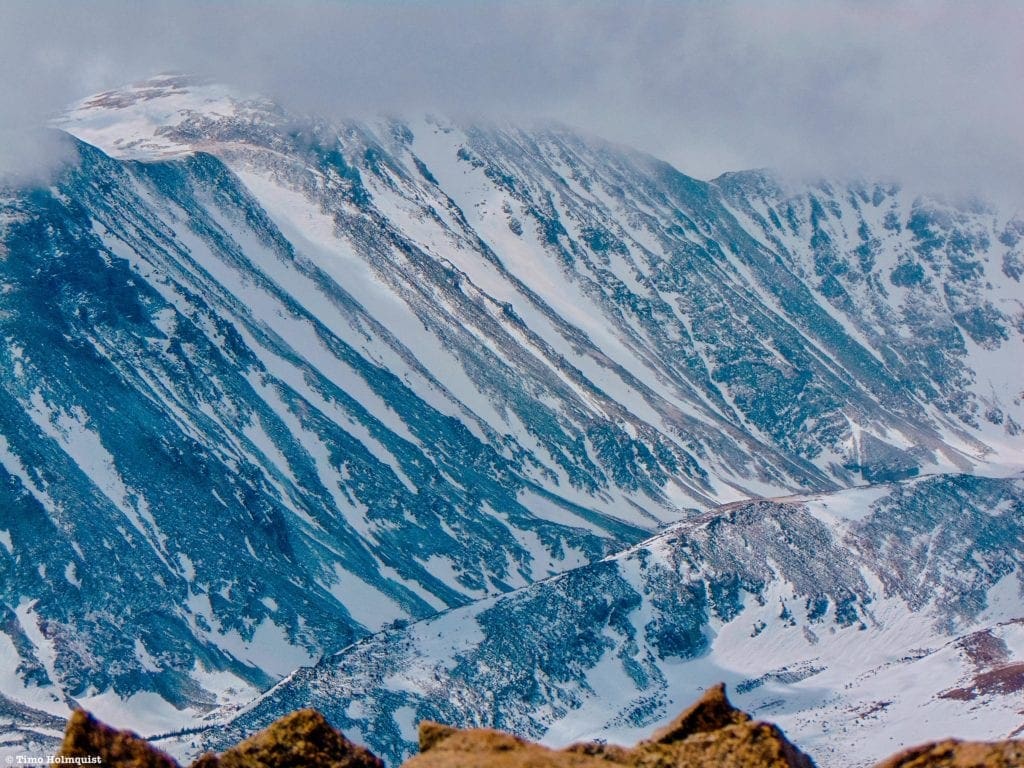
Steep slopes and contrasts.
Can you hear the chirping of pikas and marmots? Can you see ridge after ridge, bleeding into the infinite? Can you feel the sun warming up extremities? Sit down and find the calm. It’s not an easy feeling to find and hard to hold on to once you have it. But in an alpine spring, it’s easy to forget the blaring car-horns of a clogged city, the screaming of children two apartments down, or the constant drone of news anchors reminding you of how much better society could be. As the information cycle shrinks, a longing to slip between the cracks grows stronger. It doesn’t mean you have to disappear forever; hermit life isn’t exactly everyone’s number one aspiration. But reflection is important, and the workweek doesn’t give us much of that: backcountry can.
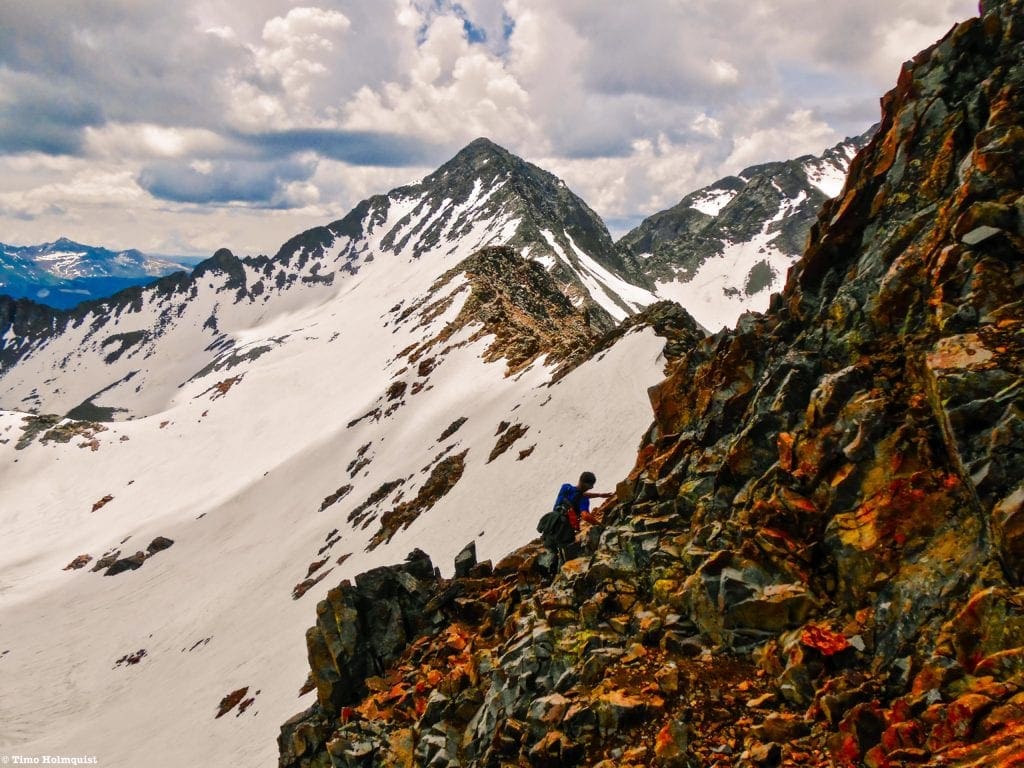
Snowfields below Gladstone Peak.
Once the calm descends and the stress of the Grind begins to fade, it’s time to focus on the downhill. In an alpine spring, contrasts are king. It’s always a unique sensation, skiing through the seasons. From winter at the top, to spring halfway down, to summer at the bottom.
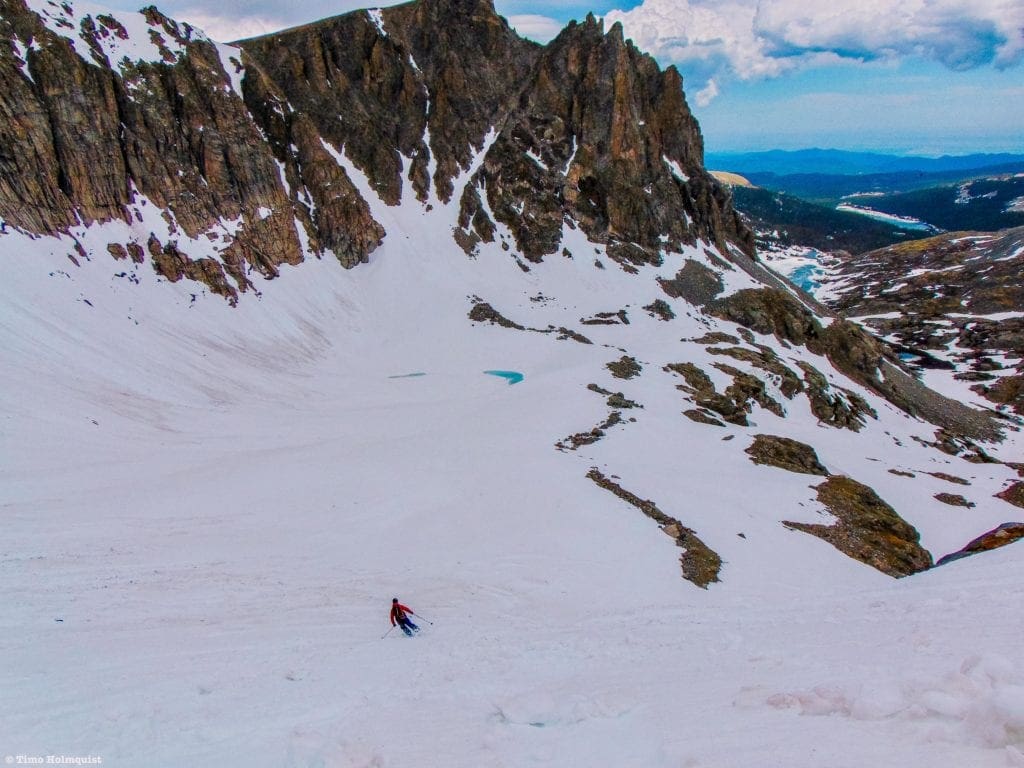
Skiing into summer.
Backcountry doesn’t start at the professional level, and a lot of the time, it never gets there, but that isn’t the scale you should be measured by. Ski your line at your pace and at your speed. Stop as many times as you want, or see if you can ski it all in one go. The important part is to play. Do you have to be able to ski glaciers, jump crevasses and send cliffs to succeed? Nope. Different strokes for different folks.
Some people get it, some people don’t. It’s not really you’re job to bludgeon others with reasons. As long as you have them, no one can take them from you. Are you going to be chasing some world record for most vertical feet skied? Or most epic line chased? Probably not. There are eight billion people in the world, chances are whatever you’re skiing has been skied before. So, do it for you.
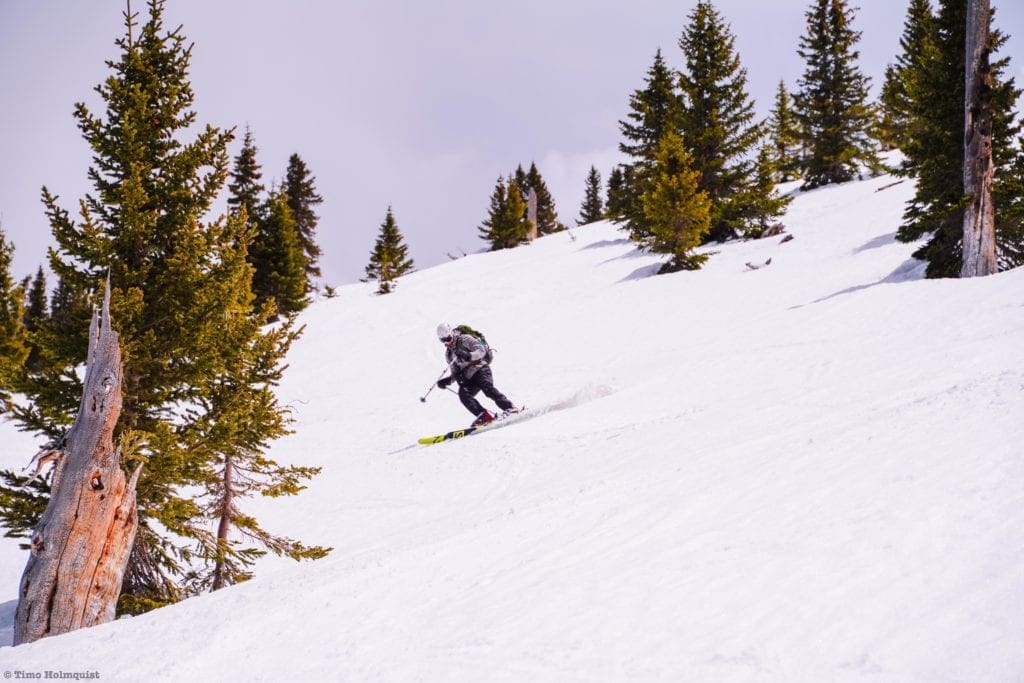
Backcountry Bliss.
One of my favorite parts of the whole snowy odyssey is owning my actions. Did I pick the right day? Did I accurately prepare? Have I figured out the dangers, and do I know how to respond to them? Do I know when to pack it in? Summit fever doesn’t just happen on Everest, and you can’t shred if you’re dead.
In a lot of ways, outdoor activities can be supremely daunting. Breaking into the industry is tough, so don’t only compare yourself to others. Do you want to experience nature in all its glorious forms? Do you like sliding around on waxy sticks? Sweet, welcome to the club. Flat brimmed hat and mustache not required for admittance, but growth and situational awareness certainly are.
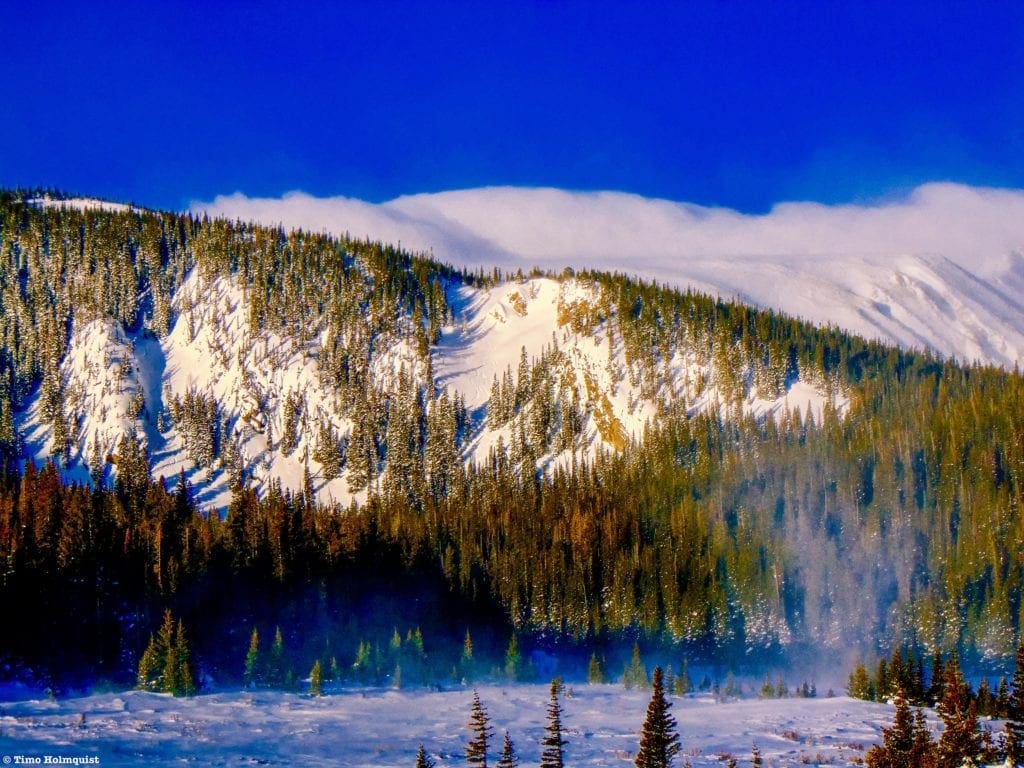
Spring ski tracks in the mountains.
Be safe, be smart, get better. Success teaches us just as much as failure. If you fail, fail with your eyes wide open. Worried about avalanches? Take a course, do the research, go with a guide. Worried about going it alone? Join a club or a group. Seek the line of best fit; it is out there.
Maybe it isn’t for you; maybe another activity calls your name. That’s ok; you don’t know what you don’t know. Let experience guide you. Hucking cliffs and launching down 60-degree couloirs looks pretty from a helicopter camera but that doesn’t mean you have to do it. What a freeing thought! Backcountry skiing is a sliding scale; from introductory areas to the extremes, you can choose your type of adventure.
There are plenty of places where skins will get you up the run you want to ski down. Treat it like the first time you skied at a resort; greens and baby blues. Once you master those, start researching tougher runs. True ski mountaineering involves ice axes, crampons, ropes, and face-melting descents. Those runs exist, but you do not have to start there.
Colorado is the PERFECT place to learn about backcountry skiing. Like any outdoor activity, it can be dangerous, but managing those risks is something we should be doing with every new activity we try. You wouldn’t windsurf in a hurricane, so don’t try to backcountry ski in a spring storm dropping 60 inches of fresh snow. The beauty of Colorado’s alpine spring is that your window for success stays open for MONTHS after the ski resorts close. Take your time, do the research, find some friends and get after it!
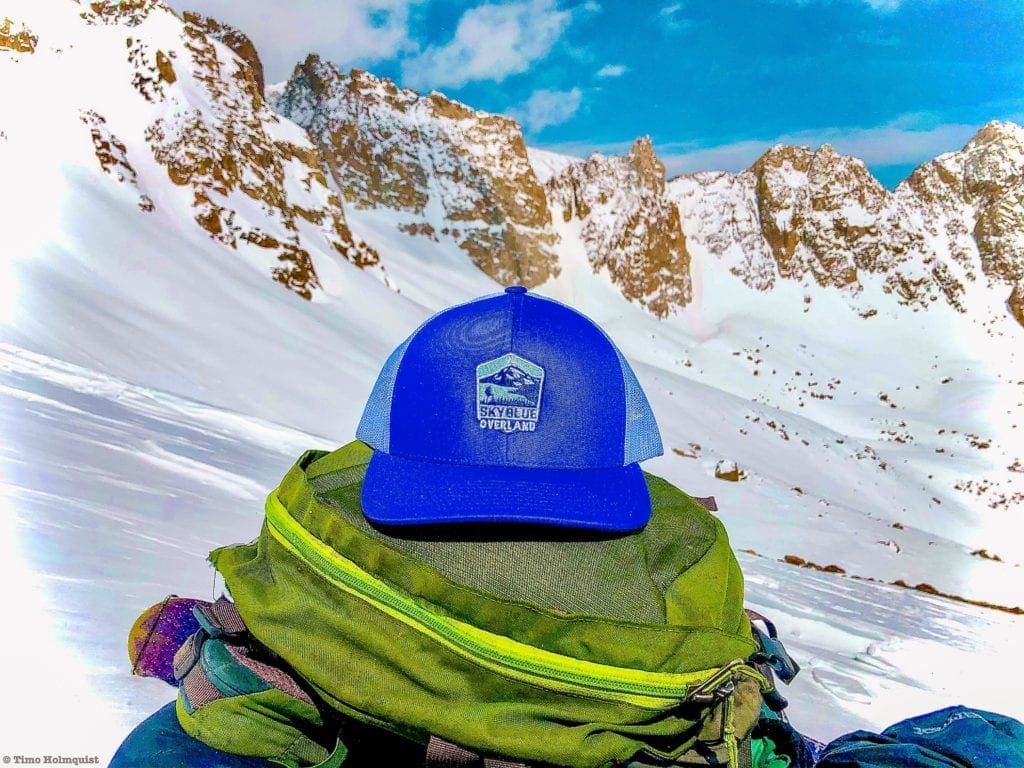
Skyblue Overland in the Backcountry.
Resources and Guides
If you’re feeling the pull to the backcountry, it’s time to get educated. Unlike other disciplines, backcountry skiing requires a lot of upfront learning to help foster success. Even masters of resort skiing won’t get backcountry right away. I’ve been doing it for years, and I am still constantly learning. As with most outdoor activities, the time spent gathering information and honing your skills is always worth it. Don’t skimp on preparedness; embrace the education.
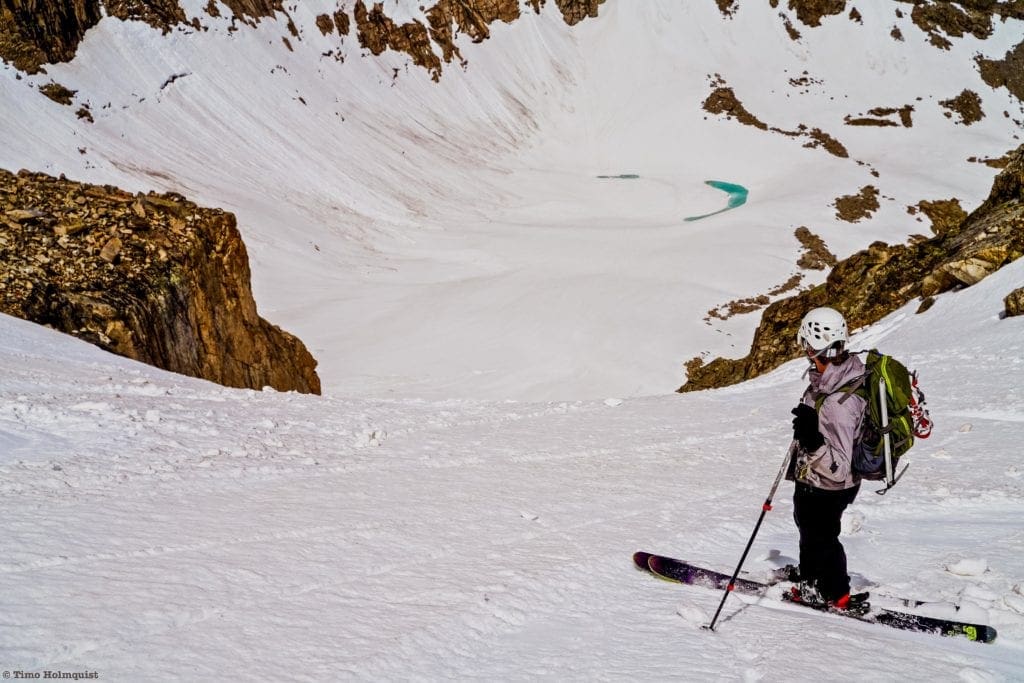
Surveying a descent line.
Backcountry Gear
Let’s lay out some quick backcountry gear knowledge. If you don’t know what some of the items are, or how to properly use them, check out our more comprehensive article, Backcountry Gear: Essentials for Human Powered Skiing. The list below is crucial, don’t skimp on gear when avalanches are in play.
- Skis/Helmet/Gloves/Goggles
- Winter Clothing: waterproof shells, thick ski socks, layers, puffy, beanie, hand warmers, etc.
- Climbing Skins
- AT Bindings (Frame or Tech)
- Avalanche Gear: Beacon, Shovel, Probe, and Radio
- Backcountry ski pack
- Food/Water/First-Aid Kit
- For multi-day adventures: 4-season tent, winter rated sleeping bag, avalanche airbag, orienteering equipment, batteries/rechargeable batteries
- Mountaineering Axe and Crampons. While there are hundreds of lines that do not require these tools, some of the most epic lines in the Indian Peaks Wilderness do. Research which crampons fit over your alpine or tech boots before buying! Generally speaking, you do not need an “Ice” axe unless you are climbing an ice wall; a mountaineering axe should work fine for most couloirs. However, some of the hardest ski mountaineering routes in the area demand more. Analyze your skill level and the route of choice BEFORE settling on gear options.
Remember, it isn’t enough to simply own gear; take the time to figure out how to use it before heading out. Speed is key, especially in a backcountry emergency situation. Visit Backcountry Gear: Essential for Human Powered Skiing to get comfortable with the necessary gear and how to use it.
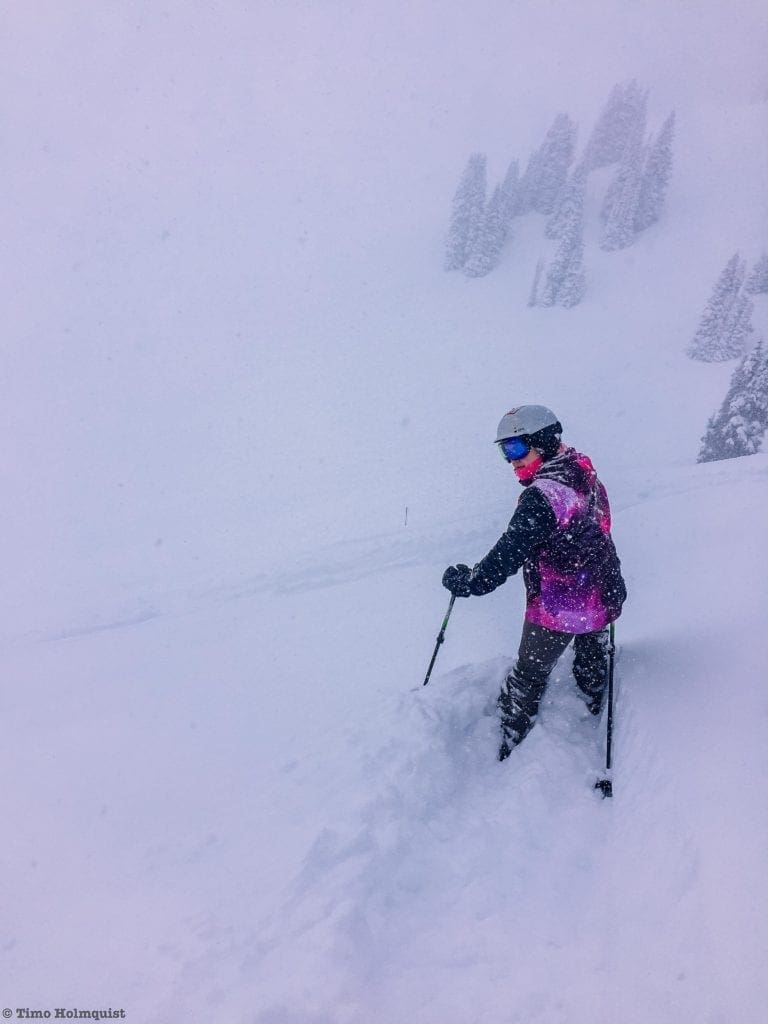
Springtime storms can drop a lot of snow quickly.
Backcountry Planning
Once you have the gear and know how to use it, it’s time to start planning. We’ll briefly break down the central components below, but check out our Guide to Planning a Backcountry Ski Adventure for an in-depth analysis of the planning process. A good plan can separate success from disaster. No outdoor activity is worth your life.
- 1) Pre-Planning
-
-
- Learn how to Ski at an EXPERT level before heading outside ski resort boundaries. Find a squad. Start backcountry gear research. Hone your craft. Get in shape.
-
- 2) Long-Term Planning
-
- Geographic reduction: where are you skiing? Start big, get small.
- Weather and snowpack research.
- Research ski lines using books, online resources, and forums. Key data:
- Total distance, total climb, total descent, slope angle
- Local Emergency contacts
- Unique factors: trees, cornices, couloirs, avalanche history
- Get into the maps and apps, know the area like the back of your hand.
- 3) Short-Term Planning
- Managing Expectations
- Constantly check weather updates until the morning you leave. Remember, snow reflects light, if it’s a sunny day, bring sunscreen!
- Popularity of your backcountry line.
- Tell people where you’re going and who to call if things go wrong.
- Have a back-up plan.
- Who’s got the medical training?
- Go over the plan in detail with your squad. CHECK FOR UNDERSTANDING.
- Packing
- Make sure everything fits, and you can access your avalanche gear quickly. Time is critical in a burial situation.
- Managing Expectations
- 4) On-site Planning
- What do you see when you get there?
- Watch out for tree-wells, wind-loaded slopes, cornices, bergschrunds, and other topographical considerations.
- Timing and snow surface i.e. environmental factors. Not all snow skis the same.
- What do you see when you get there?
- 5) Post-Planning
- Analyze
- What worked well? What didn’t?
- Ease into the harder stuff.
- Analyze
The steps listed above are only a skeleton outline; see our Guide to Planning a Backcountry Ski Adventure to iron out the critical details. Remember, you can always take an avalanche safety course through AIARE; it can absolutely save lives.
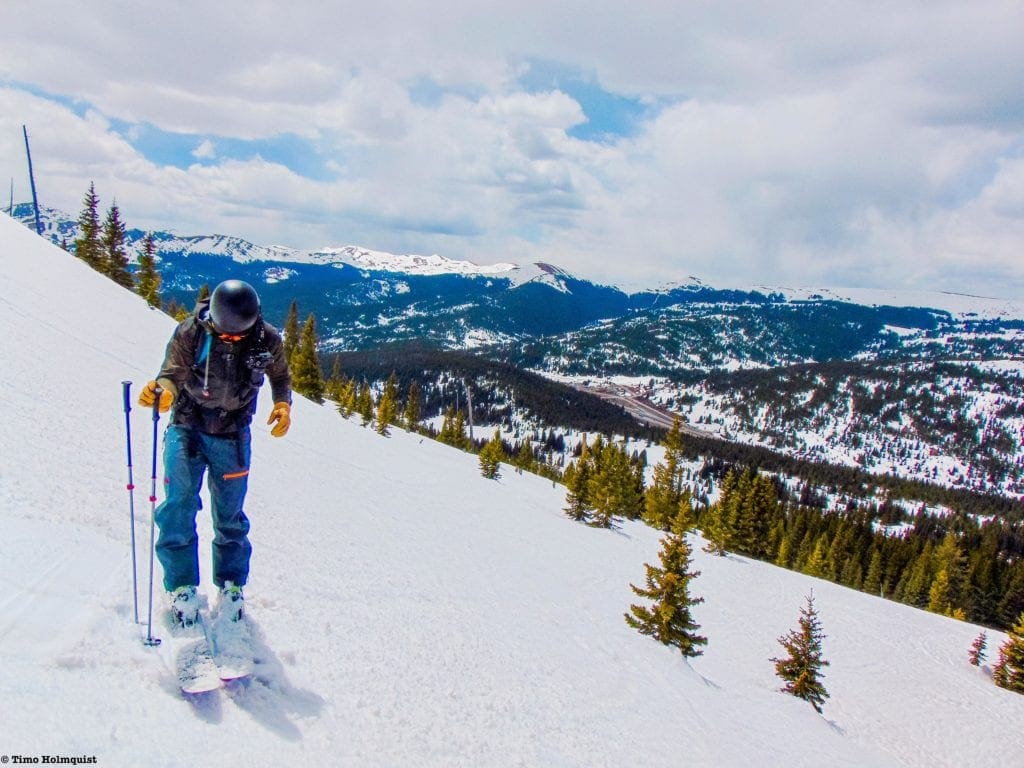
Popular areas don’t always deliver backcountry solitude, but being near a highway or a town can do wonders for confidence and will cut down on emergency response times should you need help. You can see I-70 in the center right portion of this photo.
Guides
If the gear and planning pieces above are enough to give you pause, have no fear, guide options exist that cater to every ability and level. There is no shame in having a professional walk you through the steps to ensure information retention and help get the process rolling.
These guys have managed to find a wonderful halfway point between resort skiing and backcountry skiing. The concept is relatively simple: no chairlifts, dedicated skin tracks, and avalanche mitigated terrain. There are also thousands of acres only accessible via guide, which you can rent from them. In all scenarios, the terrain has either been avalanche checked or will be evaluated by a trained professional while you’re out there. The only downside is that their season runs about the same length as most resorts, so if you want to try them, find time between Dec-early April.
Named for the number of hours between 3 PM Friday and midnight Sunday, 57 Hours makes it easy to own your weekend, connecting you to experienced local guides and untapped adventure potential.
Operating out of Summit County and right in the thick of the mountains, Colorado Adventure Guides offers numerous backcountry adventure options, all with enthusiastic and certified guides. You can also take avalanche education courses through them, which will help give you the tools to take your adventures into the wild.
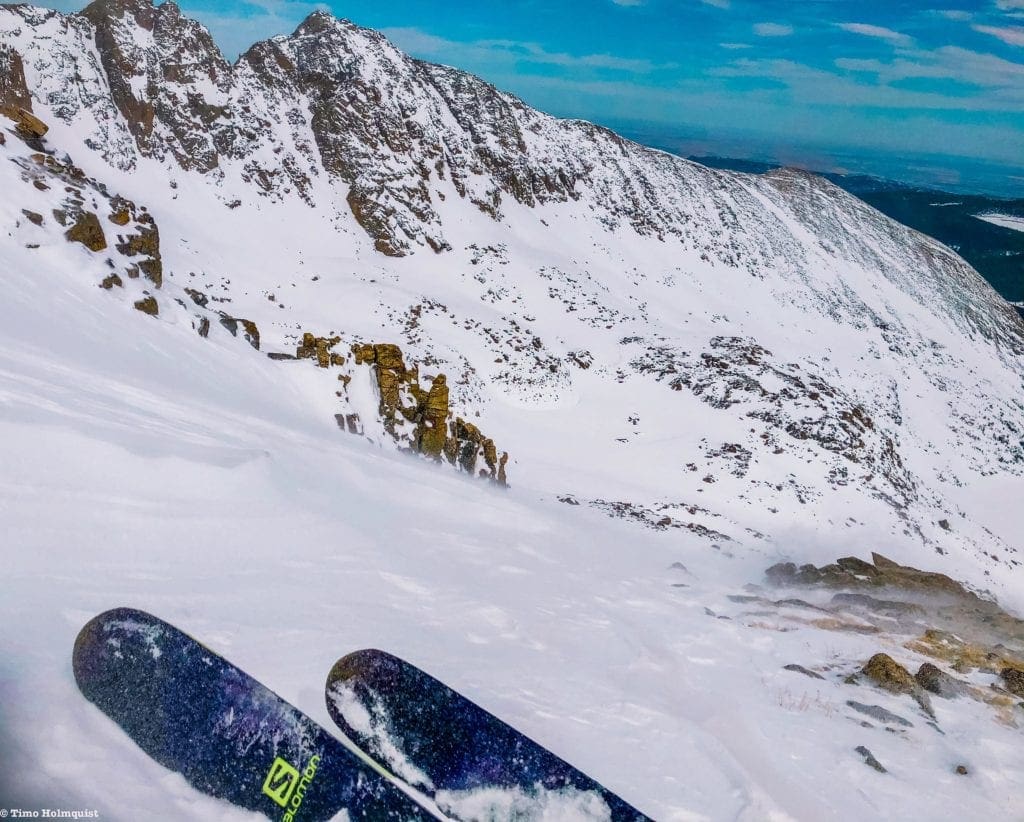
Complex terrain in the alpine.
Education
When looking at winter backcountry and avalanche education, look for the following items.
- Accreditation: whoever you take your course with, make sure they have been vetted as an organization to ensure you are getting the information you need.
- Experience: It should go without saying that your guides and instructors need to have personal and professional experience in the backcountry realm.
- Multiple course options: Education has never been a “one and done” type of discipline. Organizations that offer multiple courses covering multiple topics can help you round out key concepts necessary to pursue more advanced backcountry recreation.
- First Aid: Always make sure someone in your party has at minimum a first aid qualification. Accidents happen.
Where to Start
Everyone has their preferred intro area, but the following options should help you prep for the backcountry in Colorado.
- Uphill access at established ski resorts. If you have a ski pass to a resort, find out if they allow uphill access. Getting into the groove of skinning helps when you have groomed and avalanche mitigated terrain.
- Bluebird Backcountry, same concept as uphill access without the groomers and chairlifts.
- Hidden Valley. This awesome backcountry intro area is located in Rocky Mountain National Park and used to be a ski resort up until the early 1990s. The lines are easy to find and easy to skin up. There are enough options to keep things interesting and plenty of space to develop uphill (and downhill) rhythm.
- 10th Mountain Huts. Scattered throughout the backcountry are stocked alpine huts that make for great winter and spring destinations. Many of the huts are fairly easy to get to and provide excellent backcountry practice while showing off a unique component of Colorado history.
- Loveland Pass. Although the area is uber-popular and within a few miles of two classic ski resorts (Loveland Ski area and Arapaho Basin), the geographic pass provides a unique backcountry opportunity. The area is easily accessible from US6, a paved mountain road traversing the region, and gives you a nice backcountry preview. Avoid weekends if possible.
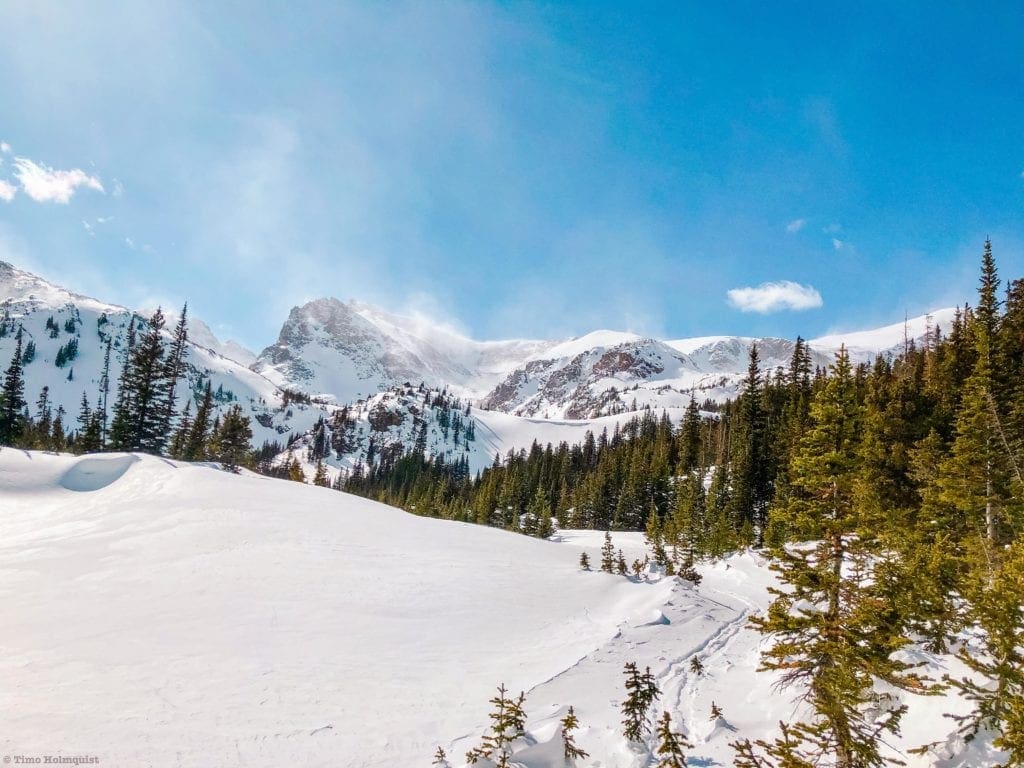
Early spring scenes.
Backcountry Terminology
- Apron: An open section of a ski line, shaped roughly like an apron. It is generally shallower at the top, wider at the bottom.
- Bootpack: A way to gain elevation utilizing the tough exterior of ski boots, literally creating steps in the slope with your ski boots. Only effective in mid-winter conditions with softer snow.
- Bergschrund: Unlike a crevasse, which tends to form in the middle of a glacier, a bergschrund, or “schrund” for short, is a crack or separation that forms between the top of a glacier and the mountain slope or stagnant snow behind it.
- Chute: An inset area along a ridge that can hold great snow and presents like a natural ski run.
- Cirque: an amphitheater-shaped head of a glacial valley, usually steep.
- Cornice: An overhung area of snow that typically forms at the crest of a ridge or cirque. While the corniced ice and snow looks compact, there is usually nothing holding it up underneath; your weight alone can collapse a cornice. A collapsed cornice may also lead to avalanches. Do not stand on the edge of a cornice or climb directly beneath one.
- Couloir: Originally a French alpinist term, a couloir is a thin skiable chute. They are typically a no-fall zone and challenging to ski effectively.
- Crevasse: A large crack that usually forms on glaciers during warmer times of year as the compact ice shifts. Very dangerous if fallen into.
- Crown: The vertical fracture line that appears after a slab avalanche, indicative of unstable terrain.
- Crux: Typically, the most dangerous section of an ascent or descent. Difficult routes can have multiple cruxes. A NO FALL ZONE.
- Glade: A treed area of a particular slope or line.
- Groomers: A type of run at a ski resort that has been plowed and “groomed” by a Snowcat. Not a naturally occurring type of snow surface but easy and enjoyable to ski.
- Headwall: A topographical term used to mark where a basin, gorge, or alpine valley ends. Headwalls are usually steep and can sport multiple couloir options.
- Line: The chosen path of skiers and snowboarders, synonymous with Run.
- Pow: Short for powder, aka fresh snow.
- Pillows: Created when deep snow buries boulders, super fun to bounce between.
- Runout: The bottom of a ski line, especially after a thin section or couloir, where the slope opens up. Similar to an apron.
- Skin: Grippy attachments applied to the bottoms of skis that aid in uphill movement.
- Skin track: The route you use to ascend a slope, very important for backcountry navigation.
- Super local: There are two versions. 1) Someone who settles in a small area and, by virtue of being there for a few decades, think they own the surrounding activities and terrain. 2) Someone who has recently moved to a new place and immediately begins telling other people how to behave.
- Stoke: Exhilaration or happiness found within a chosen activity, like skiing. The higher the stoke, the more excited you are to be doing the thing you’re doing.
- Summit Fever: The strong urge to summit something (or complete an activity) regardless of situations on the ground. This mentality can often outstrip situational awareness and lead to disastrous consequences, especially in remote areas. Safety must always come first.
- Terrain Trap: An area where snow from an avalanche can collect and bury a victim. More broadly, an area where it is difficult to ski out of once entered.
- Wind-Slab: An area of compacted snow: formed by gusty winds. If near a steep slope, they can collapse and cause avalanches. Wind-slabs are often called wind-loaded slopes as well.
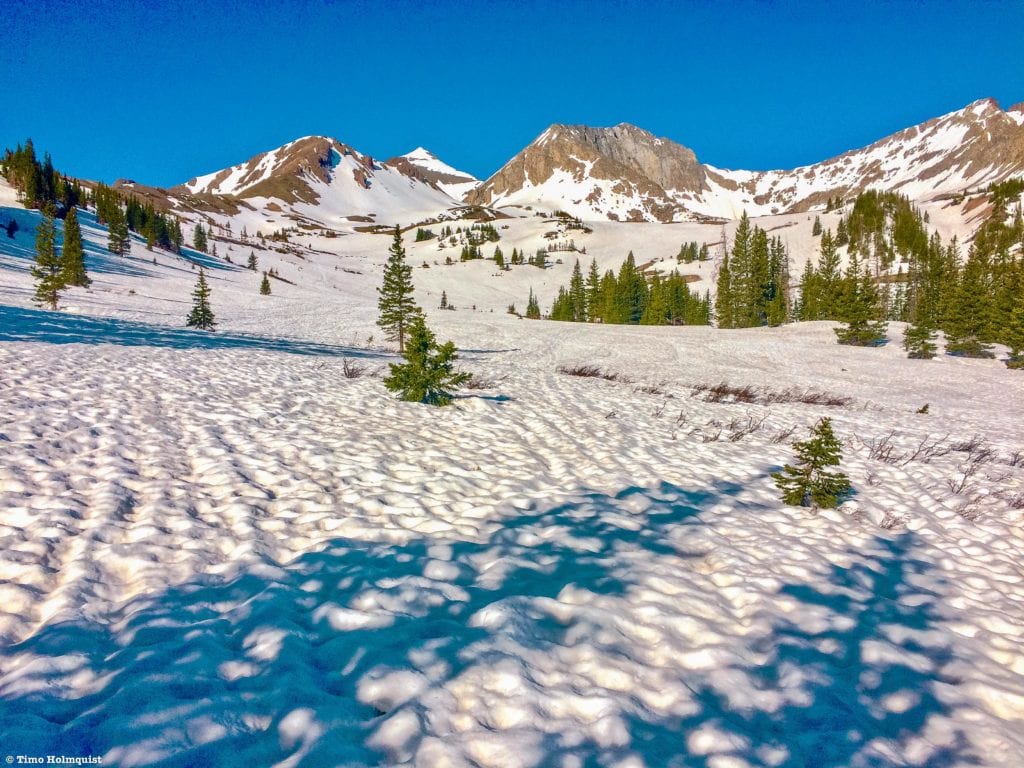
American Basin, Never Summer Mountains.
Further Reading
AIARE, Avalanche Research Education. (n.d.) Retrieved from https://avtraining.org/
Bluebird Backcountry. 2021. Colorado’s Backcountry Area. Retrieved from https://bluebirdbackcountry.com/
Colorado Avalanche Information Center. (n.d.) Retrieved from https://www.avalanche.state.co.us/
Colorado Adventure Guides. 2020. Retrieved from https://www.coloradoadventureguides.com/
Colorado Outward Bound. 2021. Retrieved from https://www.cobs.org/
Dawson, Lou. 2019. Rating Ski Descents-D System. Retrieved from https://www.loudawson.com/rating-ski-descents-d-system/
Leave No Trace. 2021. Retrieved from https://lnt.org/
Outside Online. (Nov. 3, 2017). The Backcountry Skiers Dictionary. Retrieved from https://www.outsideonline.com/2257716/adventure-backcountry-skiers-dictionary
Powder Project. 2021 Retrieved from https://www.powderproject.com/
57 Hours. (n.d.) Retrieved from https://57hours.com/
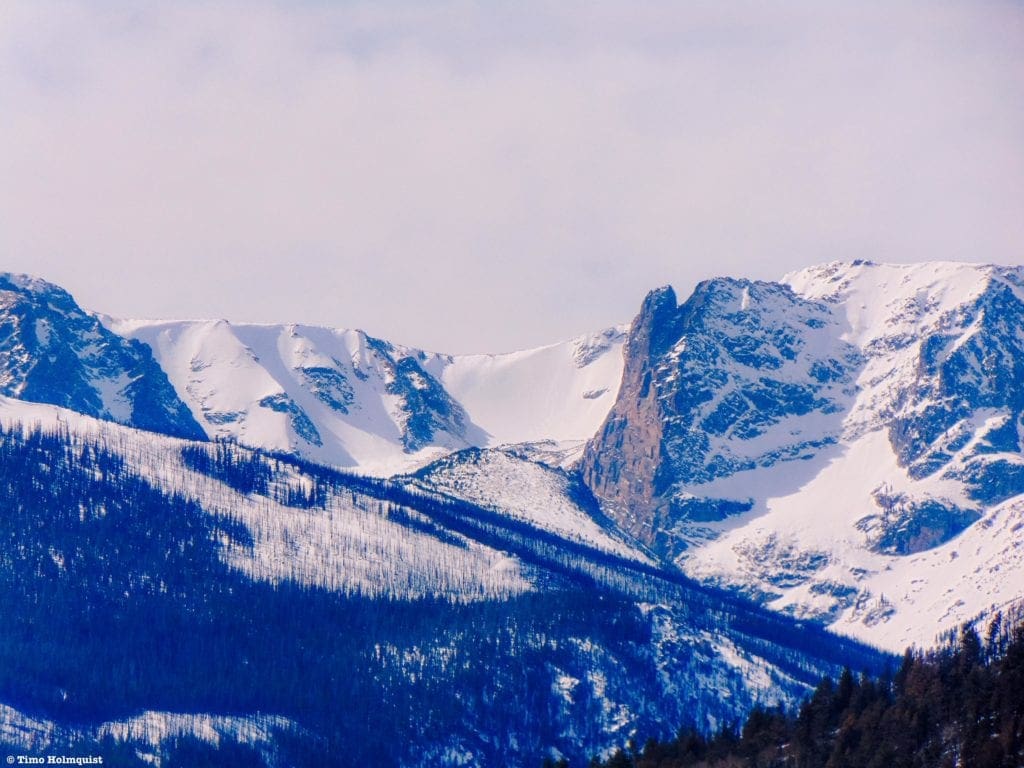
Ptarmigan Glacier in Rocky Mountain National Park, Colorado.











